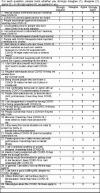Internalized stigma related to COVID-19 and its psychosocial and mental health correlates: a multicentric health facility based observational study from Nepal
- PMID: 38419690
- PMCID: PMC10900515
- DOI: 10.3389/fpsyt.2023.1276369
Internalized stigma related to COVID-19 and its psychosocial and mental health correlates: a multicentric health facility based observational study from Nepal
Abstract
Introduction: The COVID-19 pandemic has led to physical and psychological complications and social consequences in the form of illness-related stigma. This study aimed (1) to assess the sociodemographic and clinical variable, as well as COVID-19 related knowledge and perception of persons admitted for COVID-19/Suspected COVID-19 in Nepal, (2) to determine their levels of COVID-19- related internalized stigma, depression, and anxiety symptoms, and (3) to evaluate the correlates of COVID-19- related internalized stigma.
Materials and methods: It was a cross-sectional exploratory study with a convenience sample of 395 participants (306 confirmed cases, 89 suspected cases) conducted between July-October 2020 in four health facilities in Madhesh and Lumbini provinces of Nepal. We used a semi-structured questionnaire to assess sociodemographic details, clinical information, COVID-19-related knowledge, perception, COVID-19-related internalized stigma, and the Hamilton Anxiety Depression Scale (HADS) in Nepali language. Descriptive statistics, correlation analyses, and linear regression analyses were performed. The level of statistical significance was considered at p < 0.05.
Results: Around 23.3% of the patients had anxiety symptoms, 32.9% had depressive symptoms, and 20.3% had high COVID-19-related internalized stigma (mean ISMI score: 2.51-4.00). Linear regression analyses showed a significant positive association of COVID-19-related internalized stigma total score, with the following eight factors, i.e., no income in the past one month (p = 0.013), below average socioeconomic status (p = 0.004), anxiety symptoms (p = <0.001), depressive symptoms (p = <0.001), recent testing positive for COVID-19 (p = <0.001), involuntary admission (p = <0.001), prior experience of being in isolation and quarantine (p = 0.045), and those who blame others for COVID-19 (p = 0.025).
Conclusion: COVID-19 survivors and suspects are vulnerable to symptoms of depression, anxiety, and COVID-19-related internalized stigma. For the first time from Nepal, our data suggests that COVID-19-related internalized stigma is associated with anxiety and depression symptoms, perceived below-average socioeconomic status, involuntary admission, prior experience of being in isolation and quarantine, recent COVID-19 positive report, self-blame, below-average socioeconomic status and no income in the past one month. Mitigating and preventing internalized stigma associated with a public health crisis such as COVID-19 is imperative by diagnosing and treating such mental health issues early and designing interventions and policies especially targeting vulnerable populations focusing on their economic background and socio-cultural beliefs.
Keywords: COVID-19; Corona virus; Nepal; anxiety; depression; internalized stigma; mental health; stigma.
Copyright © 2024 Shah, Mahapatra, Singh, Mishra, Daha, Pande, Neupane, Banjade, Khatik, KC, Mandal, Pokharel, Gupta and GC.
Conflict of interest statement
The authors declare that the research was conducted in the absence of any commercial or financial relationships that could be construed as a potential conflict of interest.
Figures
Similar articles
-
Internalized stigma in patients with schizophrenia: A hospital-based cross-sectional study from Nepal.PLoS One. 2022 Mar 11;17(3):e0264466. doi: 10.1371/journal.pone.0264466. eCollection 2022. PLoS One. 2022. PMID: 35275907 Free PMC article.
-
Prevalence and factors associated with depression, anxiety, and stress symptoms among home isolated COVID-19 patients in Western Nepal.Dialogues Health. 2023 Dec;2:100090. doi: 10.1016/j.dialog.2022.100090. Epub 2022 Dec 5. Dialogues Health. 2023. PMID: 36624774 Free PMC article.
-
Depression-Anxiety Symptoms and Stigma Perception in Mothers of Children with Autism Spectrum Disorder.Noro Psikiyatr Ars. 2019 Nov 28;57(1):50-55. doi: 10.29399/npa.23655. eCollection 2020 Mar. Noro Psikiyatr Ars. 2019. PMID: 32110151 Free PMC article.
-
Beyond physical health: the role of psychosocial challenges and stigma in tackling the COVID-19 pandemic-A scoping review.Front Psychiatry. 2023 Jul 11;14:1180252. doi: 10.3389/fpsyt.2023.1180252. eCollection 2023. Front Psychiatry. 2023. PMID: 37496686 Free PMC article.
-
Mental health-related structural stigma and discrimination in health and social policies in Nepal: A scoping review and synthesis.Epidemiol Psychiatr Sci. 2023 Dec 13;32:e70. doi: 10.1017/S2045796023000823. Epidemiol Psychiatr Sci. 2023. PMID: 38086740 Free PMC article.
Cited by
-
Psychological responses and factors associated with depression and anxiety in entry personnel under quarantine during pandemic in China.Front Public Health. 2024 Oct 3;12:1368463. doi: 10.3389/fpubh.2024.1368463. eCollection 2024. Front Public Health. 2024. PMID: 39421807 Free PMC article.
References
-
- Corrigan PW, Watson AC. The paradox of self-stigma and mental illness. Clin Psychol Sci Pract. (2002) 9:35–53. doi: 10.1093/clipsy.9.1.35 - DOI
-
- Ugidos C, López-Gómez A, Castellanos MÁ, Saiz J, González-Sanguino C, Ausín B, et al. . Evolution of intersectional perceived discrimination and internalized stigma during COVID-19 lockdown among the general population in Spain. Int J Soc Psychiatry. (2022) 68:55–63. doi: 10.1177/0020764020975802, PMID: - DOI - PMC - PubMed
-
- Mawar N, Sahay S, Pandit A, Mahajan U. The third phase of HIV pandemic: social consequences of HIV/AIDS stigma & discrimination & future needs. Indian J Med Res. (2005) 122:471–84. PMID: - PubMed
LinkOut - more resources
Full Text Sources
Research Materials
Miscellaneous


